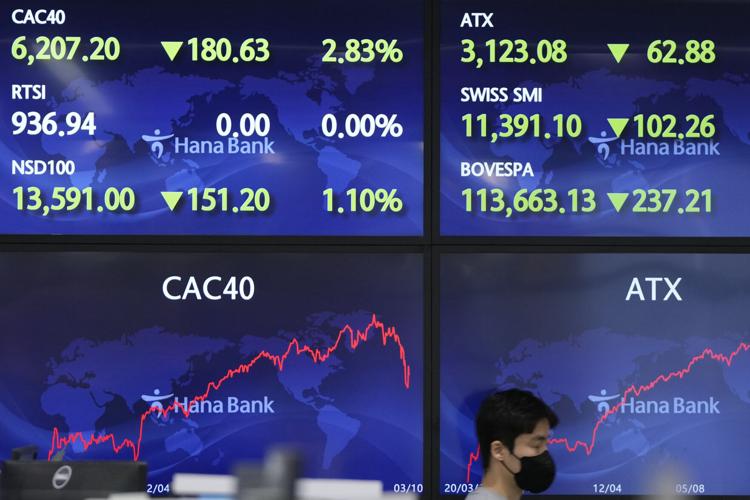Asian shares sink as war, inflation hold sway on markets

Shares fell Friday in Asia as uncertainty over the war in Ukraine and persistently high inflation kept their sway over markets.
BANGKOK, TGO: Shares fell Friday in Asia as uncertainty over the war in Ukraine and persistently high inflation kept their sway over markets. Hong Kong fell 3.2% and Tokyo was 2.6% lower. Investors are fretting over how the world economy may struggle with price pressures and slowing growth.
A plan to revoke Russia’s most favored nation trade status over its invasion of Ukraine added to unease over the economic repercussions of the deepening conflict after talks between foreign ministers of the two countries failed to show any concrete progress.
President Joe Biden plans to announce the change Friday, according to a source familiar with the matter who spoke on the condition of anonymity to preview the announcement. Pressure has been building in Washington to revoke what is formally known as “permanent normal trade relations” with Russia, allowing the U.S. and allies to impose tariffs on Russian imports.
Tokyo’s Nikkei 225 index was down 660 points at 25,032.61 and the Hang Seng in Hong Kong shed 667 points to 20,222.79.
The Shanghai Composite index lost 2.2% to 3,224.92 after Chinese Premier Li Keqiang, the country’s No. 2 leader, said the government hopes to generate as many as 13 million new jobs this year while trying to reverse a painful economic slowdown.
Premier Li Keqiang promised “pro-job policies” including tax and fee cuts totaling 2.5 trillion yuan ($400 billion) for businesses. Economic growth slid to 4% over a year earlier in the final quarter of 2021, down from the full year’s 8.1% expansion.
Surging coronavirus cases in both the Chinese mainland and Hong Kong have added to concerns dogging their markets. The Kospi in Seoul declined 1.1% to 2,651.22. In Australia, the S&P/ASX 200 gave up 0.7% to 7,079.10. India gained 0.2% but other regional markets declined.
Investors are keeping to the sidelines ahead of the weekend, given the potential for big surprises while markets are closed, analysts said.
“When confidence is low, risk managers are in the drivers’ seat, keeping bank and market maker liquidity to a minimum which could be exacerbating inter-day moves,” Stephen Innes of API Asset Management said in a commentary.
“And no wonder as predicting day-to-day market actions is about as consistent as flipping a coin,” Innes said.
Stocks slipped on Wall Street Thursday in choppy trading while oil prices bounced, with a barrel of U.S. crude jumping as much as 5.7%, before ending down 2.5%. A day earlier, benchmarks had surged to their biggest gain since June 2020 when a tumble for oil prices seemed to take some pressure off the world’s high inflation.
The S&P 500 dropped 0.4% to 4,259.52. The benchmark index is now 11.2% below the all-time high it set early this year. The Dow Jones Industrial Average fell 0.3%, to 33,174.07, while the tech-heavy Nasdaq composite slid 0.9% to 13,129.96.
Smaller company stocks held up better than the broader market. The Russell 2000 lost 0.2%, to 2,011.67.
Oil’s back-and-forth moves are just some of the waves buffeting markets. The European Central Bank said high inflation will push it to wrap up its bond-buying program meant to boost its economy faster than expected. In the U.S., a report showed that consumer prices leaped 7.9% in February from a year earlier. It’s the sharpest spike since 1982, though the reading was largely within expectations.
Volatility has become the norm since Russia’s invasion of Ukraine . It has raised worries about how high prices will go for oil, wheat and other commodities produced in the region.
Investors already were on edge before the war because high inflation is pushing central banks to raise interest rates for the first time since the pandemic began and halt programs launched to support the global economy.
Analysts said Thursday’s U.S. inflation report was what economists were forecasting, and it did not include the most recent surge for oil and gasoline prices following Russia’s invasion of Ukraine. It also didn’t hit the 8% threshold that might trigger alarm.
Many investors said the report likely won’t change anything for the Federal Reserve, which is expected to raise its key short-term rate by a quarter of a percentage point next week, the first hike since 2018. Higher rates slow the economy, and the Fed is trying to raise them enough to tamp down inflation but not so much that it causes a recession.
Oil prices have moderated since their wild swings earlier in the week.
U.S. benchmark crude added 26 cents to $106.28 per barrel after falling Thursday by $2.68 to $106.02 per barrel.
Brent crude, the basis for international pricing, lost 19 cents to $109.14 per barrel.
Both it and U.S. benchmark oil are up more than 40% for 2022 so far, though they remain below the peaks they hit earlier this week, when U.S. oil briefly topped $130.
The yield on the 10-year Treasury, which tracks expectations for inflation and economic growth, wavered immediately after the inflation report’s release. It rose to 2% from 1.94% late Wednesday. Early Friday it was at 1.97%.
The U.S. dollar rose to 116.51 Japanese yen from 116.11 yen and the euro rose to $1.1002 from $1.0987.


